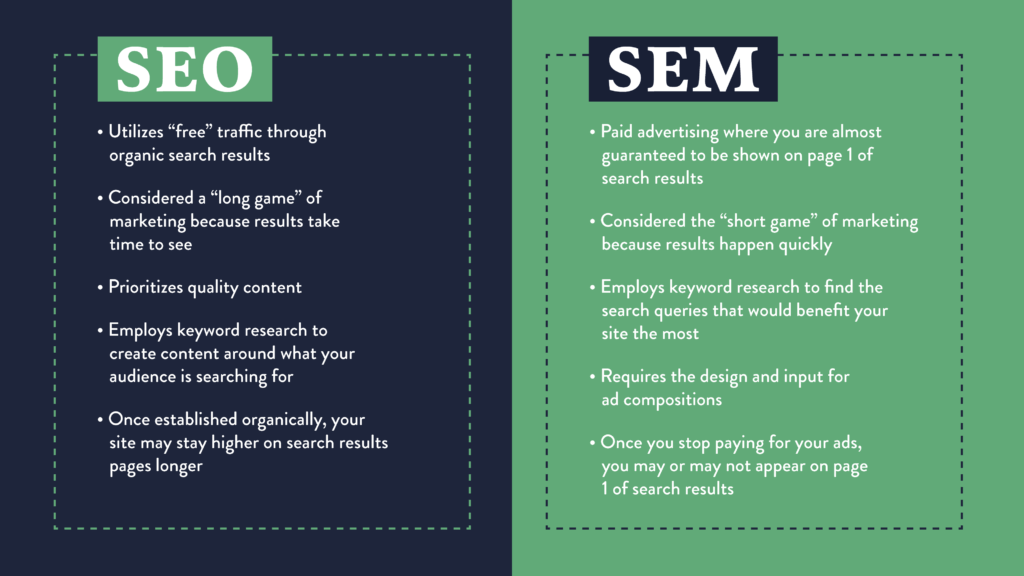Sometimes SEO (search engine optimization) is classified as part of SEM (search engine marketing) but this is not entirely accurate. The main difference between SEO and SEM is that SEM utilizes paid marketing while SEO utilizes optimizations on your web pages. Both have a goal of increasing visibility in search engines.
Let’s look at both SEO and SEM and how they could benefit your digital marketing strategy.
The Two Main Parts of SEO
SEO is the process of optimizing your website for the purpose of getting free traffic from search engines through organic traffic. Search engine crawlers understand an optimized webpage more easily. This increases the chances of ranking higher in SERPs (search engine result pages).
There are two main parts of a successful SEO strategy: on-page SEO optimization and link building. Below is a quick summary of SEO. For more in-depth information, check out our blog post Dogwood’s Guide to SEO.
On-Page SEO
On-page SEO, sometimes called on-site SEO is a set of rules you can apply to your website or blog so that it’s search engine friendly. Search engines are trying to understand what the main topic of your website content is so that they can best match it with a user’s query. SEO is making small changes to your web pages that help search engines know exactly what your content is about.
Some examples of on-page SEO are using optimized titles, good meta descriptions, well-formatted URLs, the correct usage of H1, H2, and alternative text with images, and much more. When executed well, search engines can easily know what your content is about and then hopefully present it higher in organic search results.
On-page SEO can be used for national and international traffic or focused locally on your immediate place of business. To learn more about targeting your local search traffic, check out our blog post Local SEO: Is it Right For You?
Link Building
Link Building, also called off-site SEO, refers to the process of getting votes from other websites to increase your website’s trust in the eyes of search engines. This may be confusing but try to think about it like a ranking system where the website that has the most votes ranks higher. This is known as site authority. “Votes” in this case are links coming from other websites to your site.
Note that successful link-building is not only a matter of how many links you have pointed to your website but also from where these links are coming. It is never a good idea to purchase backlinks to improve SEO. The quality of the site that is linked to your website matters in search engine results.
To learn more about link building, check out our blog post: Site Authority and Your SEO Strategy.
SEM
Search Engine Marketing (SEM) is paid advertising to help you rank higher in search results.
Through paid search advertising you essentially buy advertising space in the search engine results. The most well-known advertising agency for paid search is Google Ads (formerly known as Adwords) Through Google Ads, you can get your website to appear in the Google search results and you pay only for the clicks on your ads. This is known as pay-per-click or PPC. Bing and Yahoo have a similar system but they are not as successful or as widely known as Google Ads.
To learn more about the different types of Google Ads offered, check out our blog posts: All About Google Ad Campaigns and the 5 Types of Google Ad Campaigns.
Understanding The Difference Between SEO and SEM
So what is the major difference between SEO and SEM?
The major difference between SEO and SEM is that SEO focuses on long-game organic growth and SEM focuses on short-game paid growth. Below is a list of other key differences between the two.

How are SEO and SEM Similar?
- Both have a goal of appearing higher on search results.
- Both require keyword research to find the best search query terms.
- Both lead to more clicks which then hopefully leads to conversions for your website.
- Both can be utilized in many different types of content (text, video, search, shopping etc)
Which is a Better Choice? SEO, SEM, or Both?
To determine which is the better choice between SEO and SEM for your marketing strategy, you must consider a number of factors such as…
- Do I need to show up quickly on search results to hopefully have more clicks and then conversions? If so, SEM may be the better choice.
- Do I have time to devote to the long game and establish a strong organic presence in search? If yes, SEO may be the better choice.
- Does my site contain quality content with pertinent keywords? If yes, SEO may be the better choice. With a few optimization tweaks, you may see great results.
- Do I consistently share blog content? Then SEO may be the better choice.
- Do I need to update the content on my website to reflect pertinent keywords but want to see faster results? If yes, then SEM may be the better choice.
- Do I have money budgeted for a monthly ad spend? If yes, then the money could be applied to SEM.
- Do I have a strong working knowledge of the demographics of my target audience? Then SEM may be the better choice because of the targeting capabilities of paid advertising.
- Do I have both the time to optimize my website (or the money to pay someone to do it) and the money to spend on paid digital advertising? If yes then enjoy the best of both worlds and pursue both SEO and SEM!
Statistically Speaking on the Difference Between SEO and SEM Traffic
A 2019 study by Brightedge found that SEO traffic to a website accounted for about 53% of the total traffic. Around 15% of traffic came from SEM. The rest of the traffic came from direct links, social media, or other sources.
Seeing that 53% statistic may make SEO seem like a no-brainer… but you must factor in the time and work it takes to rank on page 1 of search results organically. Remember that SEO is a long game? We recommend evaluating SEO performance after a minimum of 3 months but more commonly at the 6-month mark to adequately evaluate your results.
While the 15% of SEM traffic statistic may seem lower, you must also account for the fact that those that clicked on those ads, were looking to purchase or act therefore making a conversion (in other words- revenue!) on those clicks more likely. The return on your investment on SEM may be worthwhile.
The Bottom Line on SEO and SEM
People use search engines to find a solution to a problem, an answer to their question, or to learn how to do something. Your site needs to be the one they see when they search for questions that you can answer.
When searchers click on a website from the search results or click on an ad, they are more likely to convert. The relevancy of the displayed websites and ads makes traffic more valuable than any of the other sources. Social Media platforms are working to optimize their advertising platforms to utilize targeted traffic but still, traffic coming directly from search engines has a better return on investment.
People are searching for answers, make sure your site shows up to give them the answers. To show up takes effort on your part. Whether through SEO or SEM, you have to do something to make that happen.
Our crew at Dogwood Media Solutions would love to help you understand more about the difference between SEO and SEM, and find the right fit for your business. Reach out to us today and let’s get a conversation started.
This article was first published in February of 2019 and has been updated to reflect new information.


